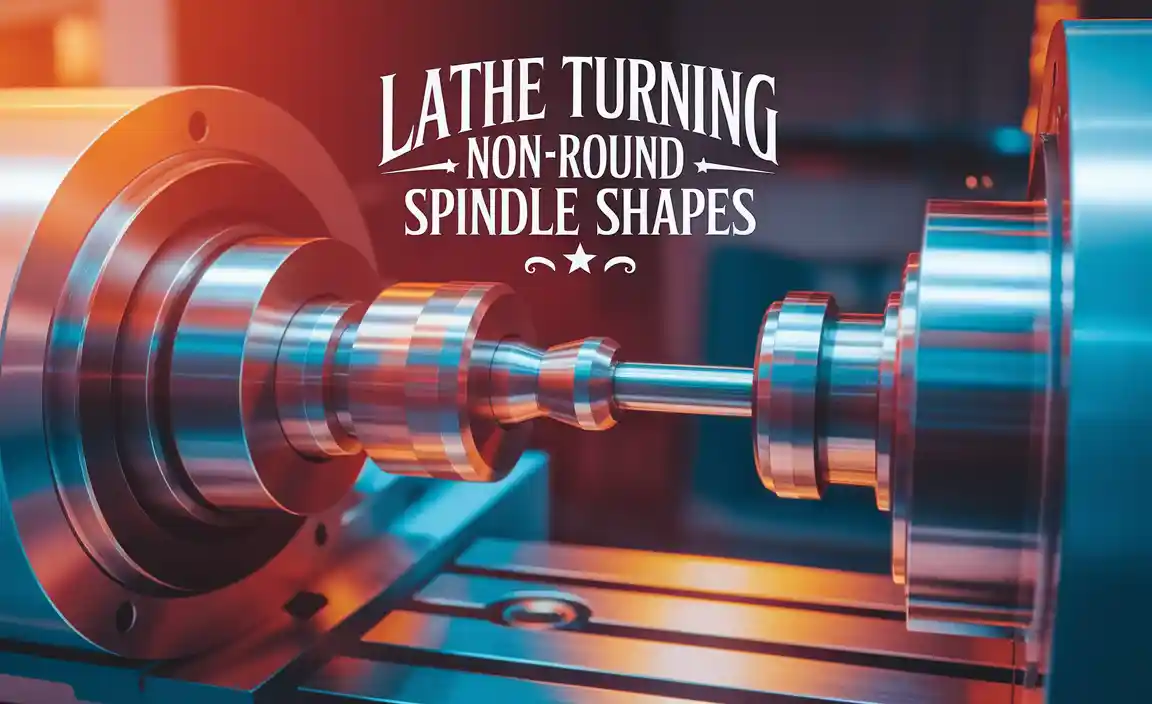Quick Summary:
A TiAlN (Titanium Aluminum Nitride) coated ball nose end mill is crucial for effectively profiling Stainless Steel 316. Its hardness, heat resistance, and lubricity prevent tool wear and improve surface finish, making complex cuts achievable for beginners.
Working with Stainless Steel 316 can be a real challenge, especially when you need to create detailed shapes or profiles. It’s tough and gummy, meaning standard tools can quickly dull, chatter, or leave a rough finish. This can be frustrating, especially when you’re just starting out. But don’t worry! There’s a specific tool that makes this job much, much easier: the TiAlN coated ball nose end mill. Today, we’ll dive into why this tool is so essential for profiling Stainless Steel 316 and how you can use it to get great results. We’ll break down everything you need to know to tackle those tricky cuts with confidence.
Why Stainless Steel 316 is Tricky (And How It Affects Tooling)
Stainless Steel 316 is a popular choice for many projects because it’s incredibly resistant to corrosion and offers good strength. However, these desirable properties also make it notoriously difficult to machine. It has a tendency to “work harden,” meaning it gets tougher the more you cut it. This high tensile strength and lower thermal conductivity mean that cutting tools experience:
- Increased Friction and Heat: The material doesn’t dissipate heat well, so it builds up at the cutting edge.
- Galling and Welding: The soft, gummy nature of stainless steel can cause it to stick or “weld” to the cutting tool, leading to rapid wear and a poor surface finish.
- Tool Breakage: The toughness and tendency to work harden can put immense stress on cutting tools, leading to chipping or complete breakage.
For beginners, these issues can turn a promising project into a frustrating experience. You might find your end mill dulling after just a few cuts, or the workpiece surface looking rough and uneven. This is where the right tooling makes all the difference.
Introducing the TiAlN Ball Nose End Mill
So, what exactly is a TiAlN ball nose end mill, and why is it so good for this specific job?
What is a Ball Nose End Mill?
A ball nose end mill is a type of cutting tool with specialized geometry. Unlike a standard flat-bottomed end mill, its tip is shaped like a hemisphere, or a ball. This shape is incredibly versatile for machining:
- Contoured Surfaces: Perfect for creating rounded edges, fillets, and complex 3D shapes.
- Slotting and Pocketing: Can cut full-radius slots or create rounded internal corners in pockets.
- Engraving: The smooth, rounded tip is excellent for detailed work.
The “ball nose” refers to this rounded tip, which allows for smooth, continuous cuts without sharp corners that can be prone to stress. For profiling, it can create a beautiful, flowing edge.
What is TiAlN Coating?
TiAlN stands for Titanium Aluminum Nitride. It’s a very hard, thin ceramic coating applied to the surface of the end mill. This coating is crucial for machining tough materials like Stainless Steel 316 because it provides:
- Exceptional Hardness: The coating is significantly harder than the base tool material, resisting wear and abrasion.
- High Heat Resistance: TiAlN can withstand very high temperatures (up to 900°C or 1650°F). This is vital because the friction generated when cutting stainless steel creates a lot of heat. The coating helps prevent the cutting edge from softening and degrading.
- Reduced Friction: The smooth nature of the TiAlN coating helps reduce friction between the tool and the workpiece. This means less heat buildup and less tendency for the stainless steel to gall or stick to the tool.
- Oxidation Barrier: It acts as a barrier, preventing the workpiece material from oxidizing and welding onto the cutting edge.
When you combine the smooth cutting action of a ball nose profile with the extreme durability and heat resistance of TiAlN, you get a powerful combination for tackling Stainless Steel 316.
The 55-Degree Advantage for Profiling
You’ll often see end mills specified with a helix angle, like 30 degrees, 45 degrees, or 55 degrees. For profiling Stainless Steel 316, a 55-degree helix angle on a TiAlN coated ball nose end mill offers a distinct advantage. Here’s why:
- Controlled Chip Load: The steeper helix angle (55 degrees) tends to produce smaller, more manageable chips. This is beneficial for gummy materials like stainless steel, as it prevents chips from packing up in the flutes, which can lead to tool breakage or a poor surface finish.
- Smoother Engagement: A steeper angle often results in a smoother engagement with the material, reducing vibration or “chatter.” Chatter is the enemy of a good surface finish and can quickly damage your tool and workpiece.
- Improved Surface Finish: The combination of controlled chip evacuation and smoother engagement directly contributes to a superior surface finish on your profiled parts. This is exactly what you want when creating detailed profiles.
- Effective for Profiling: While a 30 or 45-degree helix is common, the 55-degree angle provides that extra bit of control and chip management ideal for the precise, often intricate paths required in profiling operations on tough materials.
So, when looking for your TiAlN coated ball nose end mill specifically for profiling Stainless Steel 316, specifying one with a 55-degree helix angle is a smart move for optimal performance.
Key Features to Look For in Your End Mill
When you’re out shopping for this specialized tool, here’s what to keep an eye on:
- Coating: TiAlN (Titanium Aluminum Nitride) is a must. Sometimes you might see AlTiN (Aluminum Titanium Nitride), which is also excellent and often has even higher heat resistance.
- Geometry: Ball nose. Ensure it’s a full ball nose, meaning the radius at the tip is consistent with the tool’s diameter.
- Helix Angle: As discussed, 55 degrees is excellent for profiling Stainless Steel 316.
- Number of Flutes: For stainless steel, 2 or 3 flutes are often recommended. More flutes (like 4) can cause chip packing issues in gummy materials. Fewer flutes allow for better chip evacuation.
- Material: High-quality solid carbide is the standard for these types of tools. Carbide offers superior hardness and wear resistance compared to High-Speed Steel (HSS).
- Diameter: Choose a diameter appropriate for your specific profiling job. Common sizes range from 1/8″ (3mm) up to 1″ (25mm) or larger.
Example Tool Specifications
Here’s what a good specification might look like for a tool suitable for this task:
| Feature | Specification | Reasoning |
|---|---|---|
| Type | Ball Nose End Mill | Essential for creating smooth contours and rounded profiles. |
| Coating | TiAlN or AlTiN | Provides extreme hardness, heat resistance, and lubricity for tough materials. |
| Material | Solid Carbide | Offers superior rigidity and wear resistance. |
| Helix Angle | 55 Degrees | Promotes controlled chip load and smoother cutting for stainless steel. |
| Number of Flutes | 2 or 3 | Aids in chip evacuation, preventing clogging in gummy materials. |
| Shank | Weldon or Plain (for rigidity) | Ensures a secure grip in the collet or tool holder. |
Setting Up for Success in Your Mill
Before you even think about pressing “go,” proper setup is key. This ensures safety, accuracy, and the longevity of your new end mill.
Selecting the Right Speeds and Feeds
This is arguably the most critical part when machining stainless steel. Too fast, and you’ll burn up your tool. Too slow, and you’ll rub and gall the material. Speeds and feeds depend on many factors like tool diameter, depth of cut, machine rigidity, and coolant usage. However, here are some general guidelines for a 1/4″ (6mm) TiAlN ball nose end mill in Stainless Steel 316:
As a general starting point, you’ll want to use relatively slow spindle speeds and moderate feed rates. High-speed machining is usually not the first approach for stainless steel with standard end mills due to heat buildup.
Many manufacturers provide recommended Speeds and Feeds charts. Always consult them if available. If not, here’s a very basic starting point:
- Spindle Speed (RPM): For a 1/4″ (6mm) carbide end mill, you might start in the range of 300-800 RPM. This is much lower than you’d use for aluminum or plastic.
- Feed Rate (IPM or mm/min): This is how fast the tool moves through the material. For a 1/4″ tool, you might start around 4-12 IPM (100-300 mm/min). This needs to be high enough to ensure the tool is cutting, not rubbing.
- Depth of Cut (DOC): For profiling, you’ll often be taking shallow radial (sideways) and axial (downward) cuts. A radial depth of cut (DOC) of 0.010″ – 0.050″ (0.25mm – 1.2mm) and an axial DOC of 0.020″ – 0.100″ (0.5mm – 2.5mm) might be appropriate, depending on the machine’s rigidity and the specific operation.
-
Chip Load per Tooth: This is a more advanced concept but is crucial for efficient cutting. For a 1/4″ 2-flute end mill, you might aim for a chip load of 0.002″ – 0.005″ per tooth (0.05mm – 0.12mm).
Calculation Example:
Desired RPM = 600
Number of Flutes = 2
Desired Chip Load per Tooth = 0.003″
Feed Rate (IPM) = RPM Number of Flutes Chip Load per Tooth
Feed Rate (IPM) = 600 2 0.003 = 3.6 IPM
Important Note: These are starting points. You will likely need to adjust based on how the machine sounds, the chip formation, and the surface finish. Always err on the side of caution and start with lighter cuts and slower speeds!
Coolant and Lubrication
Machining Stainless Steel 316 generates a significant amount of heat. Without proper coolant or lubrication, your TiAlN coating will struggle, and the material will gall. Options include:
- Flood Coolant: A constant stream of coolant directed at the cutting zone is ideal. It cools the tool and workpiece, flushes chips away, and lubricates the cut.
- MQL (Minimum Quantity Lubrication): A fine mist of lubricant and air directed at the cutting zone. It’s more efficient than flood coolant for some operations and reduces waste.
- Cutting Fluid/Wax: For manual milling, applying a dedicated cutting fluid or a specialized cutting wax directly to the area can help manage heat and improve lubricity.
For beginners, using a good quality cutting fluid designed for stainless steel is a must if flood coolant isn’t available.
You can find more information on machining stainless steels from resources like the Metalforming Association, which often publishes valuable data on machining parameters.
Workholding and Rigidity
Stainless steel requires a very rigid setup. Any flex in your workpiece or machine will lead to chatter and poor results.
- Secure Clamping: Ensure your workpiece is clamped down firmly. If you’re milling a block, use strong clamps that don’t interfere with the toolpath. For specific parts, a custom fixture might be necessary.
- Minimize Tool Stickout: Use the shortest possible length of your end mill extending from the collet or tool holder. Excessive stickout reduces rigidity and can lead to vibration.
- Sturdy Machine: A solid, well-maintained milling machine is crucial. Light-duty hobby machines may struggle with stainless steel, especially with aggressive cuts.
Step-by-Step Profiling Guide
Let’s get down to business. Here’s how you can approach profiling Stainless Steel 316 using your TiAlN ball nose end mill:
Step 1: Prepare Your File (CAD/CAM)
If you’re using CNC, you’ll need a digital model of your part. Create your profile in CAD software. Then, in your CAM software, define the toolpath. For profiling:
- Select the Tool: Accurately input the diameter, number of flutes, and any other specs of your TiAlN ball nose end mill.
- Define the Path: Choose a “profiling” or “contour” strategy. The software will typically generate a path that follows your design.
- Set Cutting Parameters: Input your calculated or researched speeds, feeds, radial depth of cut, and axial depth of cut. Start conservatively!
- Add Lead-in/Lead-out moves: These are gentle ramps or arcs that help the tool enter and exit the material smoothly, preventing harsh impacts.
Step 2: Set Up Your Machine
- Install the End Mill: Secure it firmly in a clean collet or tool holder. Ensure the shank is properly seated.
- Set Z-Zero: Carefully find the top surface of your workpiece (or your desired zero point) using a touch probe, edge finder, or a dial indicator. This is critical for accurate depth control.
- Set X and Y Zero: Locate the starting point for your profile.
- Prepare Coolant: Ensure your coolant system is ready, flood coolant is on, or have your spray/applied lubricant ready to go.
Step 3: Perform a Dry Run
Before engaging the material, run the program with the spindle off (or at a safe, low speed with the tool just above the workpiece). Watch the toolpath carefully to ensure it matches your expectations and there are no collisions.
Step 4: Make the First Cut
Start the spindle and initiate the cutting feed. Pay close attention to:
- Sound: Listen for any unusual grinding, chattering, or squealing.
- Chip Formation: Are the chips small and silvery, or are they large, stringy, and turning blue (indicating overheating)?
- Surface Finish: Is the surface smooth, or is it rough and torn?
If anything seems wrong, stop the machine immediately.







